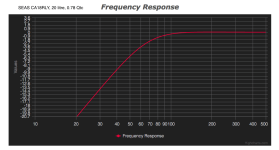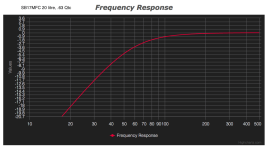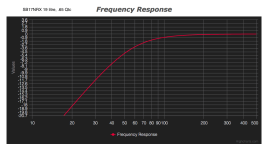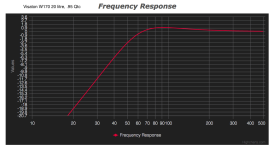I've been looking at Sound Imports. They have good stocks. I now have a shortlist I can start adding to. The Troels G. CA18RLY design looks very viable.
http://www.troelsgravesen.dk/SEAS_CA18RLY-COMPACT.htm

http://www.troelsgravesen.dk/SEAS_CA18RLY-COMPACT.htm

They need to - they are built for small reflex volumes.Yeah, most of today's drivers are so stiff it's effective motor strength (Qts') dominates.
(Qts'): (Qts) + any added series resistance (Rs)
Not sure if there are chassis left with linear and soft suspension (not progressive and medium to stiff as you need for reflex)
try also to create an id to see the good prices at https://en.toutlehautparleur.com/speaker-seas-ca18rly-8-ohm-6-93-inch.html
84.37 euros for the 18 ca rly if you take two, they ship fast too.
84.37 euros for the 18 ca rly if you take two, they ship fast too.
Last edited:
You'll want something with a large spider and soft surround. Acoustic suspension drivers can work ok in ported boxes, but are very susceptible to running out of excursion limited power handling. The Seas would be my pick from that list for a smaller sealed box.
@andyjevans Jazz musician here too. I like natural sounding bass without anything "sprinkled" on top. It needs to extend as far down as possible, but given the choice I'd pick tight bass over extension any day.
Acoustic upright bass does indeed slam if you want it too, but that often means it's being DI-ed with pickups, not miced. I have a Steinberger upright with separate pickups for every string and piezos as well. When recorded through pickups it sounds more natural than a close miced traditional upright, which tends to sound mushy and sloppy (some would call this warm sounding).
Small midbass drivers in sealed boxes provide that tight sound, which is accurate and can be warm if EQed for it. You can't EQ for tighter sound if Qtc is already high. Also, lower Qtc can usually handle more power than a less dampened higher Qtc system until you reach a Qtc of roughly 0.57 (critically dampened).
In the case of a ported box midbass, you're typically dealing with 4th order HP rolloff response to a sub or larger LF, which doesn't integrate well from the resulting large relative phase shift along with the mixed order slopes you end up with. This creates havoc with the room modes and worsens their influence on low end linearity. Sealed systems can privide better control of room modes than ported ones.
For accurate impulse response, this all means you have to stay out of the box rolloff area, even with a sealed box, in order to avoid combining the electrical (crossover) rolloff with acoustical box rolloff. The sealed box needs to be large enough for this to work out if you want the best driver integration obtainable.
Once you end up with mixed driver rolloff slopes, it starts sounding uncontrolled and sloppy, which can be impossible to fix afterwards. That's why its important to choose your filters carefully along with the drivers and enclosure parameters, so you can avoid most of the usual issues trying to integrate them all correctly.
Using linear phase filtering with DSP can fix alot, but it comes with other penalties, such as pre-ringing, but its the only practical way to somewhat fix or improve a compromised design... within reason.
Acoustic upright bass does indeed slam if you want it too, but that often means it's being DI-ed with pickups, not miced. I have a Steinberger upright with separate pickups for every string and piezos as well. When recorded through pickups it sounds more natural than a close miced traditional upright, which tends to sound mushy and sloppy (some would call this warm sounding).
Small midbass drivers in sealed boxes provide that tight sound, which is accurate and can be warm if EQed for it. You can't EQ for tighter sound if Qtc is already high. Also, lower Qtc can usually handle more power than a less dampened higher Qtc system until you reach a Qtc of roughly 0.57 (critically dampened).
In the case of a ported box midbass, you're typically dealing with 4th order HP rolloff response to a sub or larger LF, which doesn't integrate well from the resulting large relative phase shift along with the mixed order slopes you end up with. This creates havoc with the room modes and worsens their influence on low end linearity. Sealed systems can privide better control of room modes than ported ones.
For accurate impulse response, this all means you have to stay out of the box rolloff area, even with a sealed box, in order to avoid combining the electrical (crossover) rolloff with acoustical box rolloff. The sealed box needs to be large enough for this to work out if you want the best driver integration obtainable.
Once you end up with mixed driver rolloff slopes, it starts sounding uncontrolled and sloppy, which can be impossible to fix afterwards. That's why its important to choose your filters carefully along with the drivers and enclosure parameters, so you can avoid most of the usual issues trying to integrate them all correctly.
Using linear phase filtering with DSP can fix alot, but it comes with other penalties, such as pre-ringing, but its the only practical way to somewhat fix or improve a compromised design... within reason.
I think I'm starting to understand this in a basic way. So if I decide on 20 litres for the sealed enclosure, the best choices in theory would be something like the SEAS CA18RLY or SB17MFC. Both would give a F3 of around 64Hz. The Visaton W170S would give a F3 of around 50Hz, but the penalty would be a Qtc of around 1. The B200 looks impossible in 20 litres, though Kef put it in sealed enclosures way smaller than ideal.

Ideally you need to factor in the amp's significant output impedance (Rs) and any other series resistance from passive filters, any tiny wire ga., etc., used that increases Qts: (Qts'): (Qts) + any added series resistance (Rs)I don't listen loud and use a 2a3 SE amp.
Double bass player here too, though not a jazz musician.
Don't be afraid to try any given woofer in a relatively large closed cab, in my experience a slow rolloff often sounds better than higher Qtc alignments.
By the way, have you considered aperiodic boxes? Can work wonders for a natural bass response from drivers with Qts on the higher side.
Don't be afraid to try any given woofer in a relatively large closed cab, in my experience a slow rolloff often sounds better than higher Qtc alignments.
By the way, have you considered aperiodic boxes? Can work wonders for a natural bass response from drivers with Qts on the higher side.
F3 of 64 Hz is not great. I'd take another look at the ScanSpeak that was recommended in one of the first replies. It had an F3 of 55. I built a smaller ScanSpeak based sealed two way a year ago that is the best small speaker I've ever owned. Accurate, clean dynamic. It's called the Ergo IX. And F3 around 53 but it took a year to break in! Something worth looking at. https://pinkfishmedia.net/forum/thr...-e-ix-mini-monitor-loudspeaker-system.112821/
I haven't got round to aperiodic boxes, but that sounds good for a B200 I assume? Kef also used a B139 size passive radiator with the B200, so that's another way to do it.Double bass player here too, though not a jazz musician. Don't be afraid to try any given woofer in a relatively large closed cab, in my experience a slow rolloff often sounds better than higher Qtc alignments. By the way, have you considered aperiodic boxes? Can work wonders for a natural bass response from drivers with Qts on the higher side.
I've never listened to a B200 but a quick glance at the datasheet makes me think they would be a good candidate for aperiodic boxes.I haven't got round to aperiodic boxes, but that sounds good for a B200 I assume? Kef also used a B139 size passive radiator with the B200, so that's another way to do it.
I used to have a pair of ElectroVoice 12" fullrange drivers that I tested in various baffles and boxes. I don't remember the model (SP12B perhaps?) or the specs but they had fairly high Qts and sounded best in semi-closed boxes, like U-baffles with the back covered with mineral wool.
They lacked both top and bottom end but as a bass player I liked them a lot, they had a kind of melodic and unforced bass response that made it very easy to hear what the bass player on the record was playing.
I'm going to build a sealed 20 litre cabinet with removable front and back to try out different speaker combinations in a 2-way. Here's the roll-off graphs for 20 litres. Looks to me like the CA18RLY is best, though the Visaton has more bass. Since my room is 4.5 x 3.5 metres I'd expect some bass boost which might be troublesome for the Visaton. All these four have crossover designs available.








Last edited:
Scan Speak 18W/8535-01 works well in closed box. I listened to 2way with ScanSpeak 9700. It is not easy to make the crossover for it though.
https://www.scan-speak.dk/datasheet/pdf/18w-8535-01.pdf
https://www.scan-speak.dk/datasheet/pdf/18w-8535-01.pdf
Last edited:
I still don't understand what you want. You talk about some vintage KEF driver as a reverence. This is not something very dynamic and you completely miss the complicated x-over which may have adapted it to the cabinet.
You have, like many beginner before you, not understood that a speaker without an individually matched x-over ist 100% useless for quality sound reproduction. The x-over is not something you just pick or calculate, but the most important thing in speaker building. You spent an hour on picking a driver and designing a cabinet, then weeks on doing the x-over. THERE IS NO WAY TO CALCULATE IT. Even as many calculators exist. Cause is, a speaker is not a simple resistor and these calculators ignore this.
The only way for you to do a nice speaker is to pick a well reputated kit and build it. Sorry, but the only truth for you.
Even if you may get a measuring microphone, you are not able to "simply" put a good speaker together. Compare it to playing tennis. Even with the most expensive bat you will not win Wimbleton. You need to know the rules, have the skills and endurance of a professional player. You do not even know the rules by now.
Please, explain what you expect from "your" speaker and we will find some nice kit for you, aviable in the post Brexit UK and well in your price range. You can be sure, allmost any possible combination of speakers in the DIYS market has a well developed kit.
Last, if you want a 20 litre cabinet, up to an 8" driver may fit. Larger radiating area will give you more dynamic reproduction with less distortion from a small amp. Many small driver depend on huge power, that is physics you can not beat.
You have, like many beginner before you, not understood that a speaker without an individually matched x-over ist 100% useless for quality sound reproduction. The x-over is not something you just pick or calculate, but the most important thing in speaker building. You spent an hour on picking a driver and designing a cabinet, then weeks on doing the x-over. THERE IS NO WAY TO CALCULATE IT. Even as many calculators exist. Cause is, a speaker is not a simple resistor and these calculators ignore this.
The only way for you to do a nice speaker is to pick a well reputated kit and build it. Sorry, but the only truth for you.
Even if you may get a measuring microphone, you are not able to "simply" put a good speaker together. Compare it to playing tennis. Even with the most expensive bat you will not win Wimbleton. You need to know the rules, have the skills and endurance of a professional player. You do not even know the rules by now.
Please, explain what you expect from "your" speaker and we will find some nice kit for you, aviable in the post Brexit UK and well in your price range. You can be sure, allmost any possible combination of speakers in the DIYS market has a well developed kit.
Last, if you want a 20 litre cabinet, up to an 8" driver may fit. Larger radiating area will give you more dynamic reproduction with less distortion from a small amp. Many small driver depend on huge power, that is physics you can not beat.
Turbowatch2 - thanks for your post, but you may not have been following the argument very closely. Of course I need a crossover design to build my speakers, and the mid-bass units I have put on my shortlist all have crossover designs available, in some cases more than one. That's why they are on the list. So there's no need to re-state the obvious, and I'd add that I have built a few pairs of speakers in the past so I'm not a beginner. But yes, I'm still in the process of understanding all the technical aspects of speaker design. I'm a quick learner, though, and as a past academic I'm good at research. So I'm not after some kind of "beginner's kit". I can construct a crossover quite easily from a published design and I have a lot of parts in stock. I build valve amplifiers so I have a well equipped workshop. So I just need the units and the crossover design.
Before I went deeper into this, I got the impression that the B200 might work in a 20 litre sealed box, but although I have a pair I'm not expecting much out of them, so I'm concentrating on 6.5" to 7" units. That's what I have already in my Mission 761 sealed speakers, which I like. So what I'm doing is upgrading to a larger and better box (thick aluminium frame) and looking at a wider choice of mid-bass units with existing crossovers. I hope that clarifies things for you.
Before I went deeper into this, I got the impression that the B200 might work in a 20 litre sealed box, but although I have a pair I'm not expecting much out of them, so I'm concentrating on 6.5" to 7" units. That's what I have already in my Mission 761 sealed speakers, which I like. So what I'm doing is upgrading to a larger and better box (thick aluminium frame) and looking at a wider choice of mid-bass units with existing crossovers. I hope that clarifies things for you.
the mid-bass units I have put on my shortlist all have crossover designs available, in some cases more than one.
I think this is where the confusion may be coming from. The way you talk about 'crossover designs' makes it sound like they are specific to the midwoofer only, and portable between systems. What I believe turbowatch is saying, is that a well-designed crossover (even just the woofer section) is specific to the woofer+tweeter+baffle layout+listening distance system, not just the woofer. It is designed by measurement and modeling of that system, not by lifting a highpass/lowpass schematic from another application of the same driver.
The other thing is that there are ways to modify the qtc of a woofer+sealed box with the crossover. So if your modeling does not include the filter, you may find the total crossover+woofer+box response to be different. This also would extend to the past systems you may have heard, in which the crossover may have changed the response from what the 'naked' woofer in that box would have produced. You can see here:
https://techtalk.parts-express.com/...at-one-capacitor-trick-for-sealed-box-woofers
for some discussion of one effect, I'm sure this has been discussed on this forum before.
For what it's worth, I don't think any of this should preclude you modeling driver candidates in your box, it's an early and easy part of designing a speaker. But it's wise to keep in mind that the real work comes in the measure-model-test-iterate cycle.
Last edited:
- Home
- Loudspeakers
- Multi-Way
- Which 6.5" mid-bass for a sealed box?